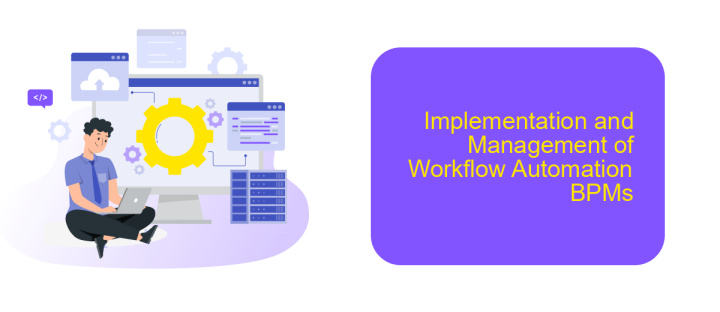Workflow Automation BPMs
In today's fast-paced business environment, workflow automation through Business Process Management Systems (BPMs) is essential for enhancing efficiency and productivity. By streamlining repetitive tasks and optimizing complex processes, BPMs enable organizations to achieve greater consistency, reduce errors, and focus on strategic initiatives. This article explores the key benefits and implementation strategies of workflow automation using BPMs.
Introduction
Workflow automation through Business Process Management Systems (BPMs) has revolutionized how organizations streamline their operations. By automating repetitive tasks, businesses can enhance efficiency, reduce errors, and allocate resources more effectively. BPMs offer a structured approach to managing workflows, ensuring that every step in a process is executed consistently and optimally.
- Improved operational efficiency
- Enhanced accuracy and reduced human error
- Better resource allocation
- Consistent execution of processes
One of the key aspects of workflow automation is the integration of various tools and services. Platforms like ApiX-Drive facilitate seamless integration, enabling businesses to connect different applications without extensive coding. This not only simplifies the process but also ensures that data flows smoothly across systems, enhancing overall productivity. As organizations continue to adopt BPMs, the role of integration services like ApiX-Drive becomes increasingly crucial in achieving a cohesive and automated workflow environment.
Understanding Workflow Automation and BPMs

Workflow automation involves the use of technology to streamline and automate repetitive tasks, ensuring that processes run smoothly with minimal human intervention. This not only saves time but also reduces the likelihood of errors and increases efficiency. Business Process Management Systems (BPMS) play a crucial role in this automation by providing a framework for designing, executing, monitoring, and optimizing business processes. BPMS allows organizations to map out their workflows, identify bottlenecks, and implement solutions that enhance overall productivity.
One of the key aspects of workflow automation is the integration of various tools and services to create a seamless operational environment. Services like ApiX-Drive facilitate this by enabling easy and efficient integration between different applications and systems. ApiX-Drive allows businesses to connect their software without the need for complex coding, ensuring that data flows smoothly between platforms. This kind of integration is vital for maintaining the consistency and reliability of automated workflows, ultimately leading to more agile and responsive business operations.
Benefits and Uses of Workflow Automation BPMs

Workflow automation BPMs (Business Process Management systems) offer numerous benefits and versatile uses for organizations looking to streamline their operations. By automating repetitive tasks, these systems enhance efficiency, reduce errors, and save valuable time. This allows employees to focus on more strategic activities, ultimately driving productivity and growth.
- Improved Efficiency: Automation reduces the need for manual intervention, speeding up processes and minimizing human error.
- Cost Savings: By optimizing workflows, businesses can cut down on labor costs and operational expenses.
- Enhanced Compliance: Automated workflows ensure that all processes adhere to regulatory standards, reducing compliance risks.
- Better Collaboration: BPM systems facilitate seamless communication and collaboration across departments, improving overall coordination.
- Scalability: These systems can easily adapt to the growing needs of a business, providing a scalable solution for workflow management.
Furthermore, integrating various applications and services is simplified with tools like ApiX-Drive, which allows for easy setup of integrations without requiring advanced technical skills. This ensures that all your business applications work in harmony, further enhancing the efficiency and effectiveness of your automated workflows. By leveraging workflow automation BPMs, organizations can achieve a higher level of operational excellence and remain competitive in a rapidly evolving market.
Implementation and Management of Workflow Automation BPMs

Implementing workflow automation BPMs requires a strategic approach to ensure seamless integration with existing processes. It begins with a comprehensive analysis of current workflows to identify bottlenecks and areas for improvement. Once identified, the next step is to design an optimized workflow that leverages automation to enhance efficiency and reduce manual intervention.
Effective management of these automated workflows involves continuous monitoring and adjustment. Key performance indicators (KPIs) should be established to measure the success of the automation and to identify areas for further optimization. Regular audits and feedback loops are essential to maintain the effectiveness of the automation over time.
- Analyze existing workflows to identify inefficiencies.
- Design optimized workflows with automation in mind.
- Implement automation tools and integrate with existing systems.
- Monitor KPIs and adjust workflows as needed.
- Conduct regular audits and incorporate feedback for continuous improvement.
Utilizing services like ApiX-Drive can significantly streamline the integration process. ApiX-Drive allows for seamless connections between various applications and systems, ensuring that data flows smoothly across platforms. This integration capability is crucial for maintaining the coherence and efficiency of automated workflows, ultimately leading to better performance and reduced operational costs.
Case Studies and Future Trends
Numerous companies have successfully implemented workflow automation BPMs to streamline their operations. For instance, a leading healthcare provider utilized BPM solutions to automate patient data management, reducing manual errors and improving patient care efficiency. Another case involves a global logistics firm that integrated BPM tools to optimize their supply chain processes, resulting in faster delivery times and significant cost savings. These examples highlight the tangible benefits of adopting workflow automation in various industries.
Looking ahead, the future of workflow automation BPMs appears promising with advancements in AI and machine learning. These technologies are expected to enhance predictive analytics and decision-making capabilities within BPM systems. Additionally, the rise of integration platforms like ApiX-Drive will play a crucial role in facilitating seamless connectivity between disparate systems, enabling more cohesive and efficient workflows. As businesses continue to embrace digital transformation, the adoption of advanced BPM solutions will likely become a standard practice, driving further innovation and operational excellence.
FAQ
What is Workflow Automation in BPM?
How can Workflow Automation benefit my business?
Is it difficult to implement Workflow Automation in my existing processes?
What types of processes are best suited for Workflow Automation?
How can I integrate different systems for Workflow Automation?
Strive to take your business to the next level, achieve your goals faster and more efficiently? Apix-Drive is your reliable assistant for these tasks. An online service and application connector will help you automate key business processes and get rid of the routine. You and your employees will free up time for important core tasks. Try Apix-Drive features for free to see the effectiveness of the online connector for yourself.

